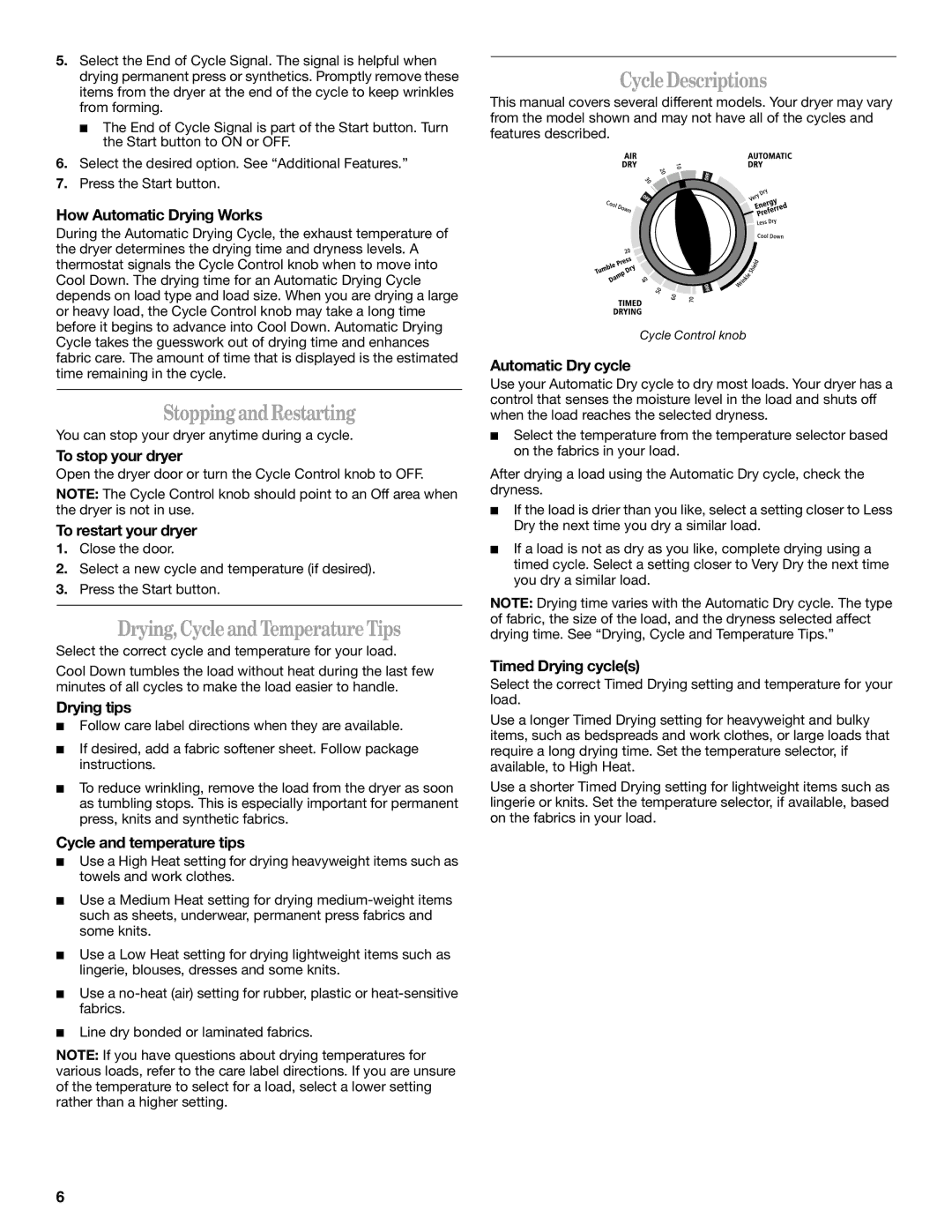
5.Select the End of Cycle Signal. The signal is helpful when drying permanent press or synthetics. Promptly remove these items from the dryer at the end of the cycle to keep wrinkles from forming.
■The End of Cycle Signal is part of the Start button. Turn the Start button to ON or OFF.
6.Select the desired option. See “Additional Features.”
7.Press the Start button.
How Automatic Drying Works
During the Automatic Drying Cycle, the exhaust temperature of the dryer determines the drying time and dryness levels. A thermostat signals the Cycle Control knob when to move into Cool Down. The drying time for an Automatic Drying Cycle depends on load type and load size. When you are drying a large or heavy load, the Cycle Control knob may take a long time before it begins to advance into Cool Down. Automatic Drying Cycle takes the guesswork out of drying time and enhances fabric care. The amount of time that is displayed is the estimated time remaining in the cycle.
Stopping and Restarting
You can stop your dryer anytime during a cycle.
To stop your dryer
Open the dryer door or turn the Cycle Control knob to OFF.
NOTE: The Cycle Control knob should point to an Off area when the dryer is not in use.
To restart your dryer
1.Close the door.
2.Select a new cycle and temperature (if desired).
3.Press the Start button.
Drying, Cycle and Temperature Tips
Select the correct cycle and temperature for your load.
Cool Down tumbles the load without heat during the last few minutes of all cycles to make the load easier to handle.
Drying tips
■Follow care label directions when they are available.
■If desired, add a fabric softener sheet. Follow package instructions.
■To reduce wrinkling, remove the load from the dryer as soon as tumbling stops. This is especially important for permanent press, knits and synthetic fabrics.
Cycle and temperature tips
■Use a High Heat setting for drying heavyweight items such as towels and work clothes.
■Use a Medium Heat setting for drying
■Use a Low Heat setting for drying lightweight items such as lingerie, blouses, dresses and some knits.
■Use a
■Line dry bonded or laminated fabrics.
NOTE: If you have questions about drying temperatures for various loads, refer to the care label directions. If you are unsure of the temperature to select for a load, select a lower setting rather than a higher setting.
Cycle Descriptions
This manual covers several different models. Your dryer may vary from the model shown and may not have all of the cycles and features described.
Cycle Control knob
Automatic Dry cycle
Use your Automatic Dry cycle to dry most loads. Your dryer has a control that senses the moisture level in the load and shuts off when the load reaches the selected dryness.
■Select the temperature from the temperature selector based on the fabrics in your load.
After drying a load using the Automatic Dry cycle, check the dryness.
■If the load is drier than you like, select a setting closer to Less Dry the next time you dry a similar load.
■If a load is not as dry as you like, complete drying using a timed cycle. Select a setting closer to Very Dry the next time you dry a similar load.
NOTE: Drying time varies with the Automatic Dry cycle. The type of fabric, the size of the load, and the dryness selected affect drying time. See “Drying, Cycle and Temperature Tips.”
Timed Drying cycle(s)
Select the correct Timed Drying setting and temperature for your load.
Use a longer Timed Drying setting for heavyweight and bulky items, such as bedspreads and work clothes, or large loads that require a long drying time. Set the temperature selector, if available, to High Heat.
Use a shorter Timed Drying setting for lightweight items such as lingerie or knits. Set the temperature selector, if available, based on the fabrics in your load.
6
